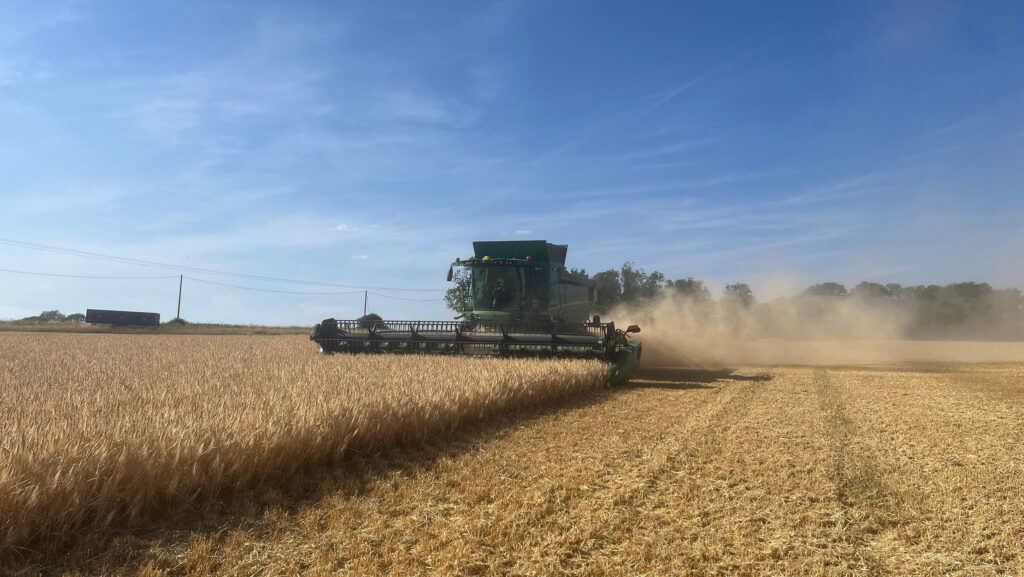‘Driest’, ‘earliest’, ‘worst’ – mixed harvest across country
 Barley harvest at Manor Farm, Bedfordshire © Emily Brown
Barley harvest at Manor Farm, Bedfordshire © Emily Brown It’s been another week of mixed results, with some crops hitting record highs and others falling short, delivering a harvest that is both rewarding and challenging.
See also: Why we could see increased demand for British oats
Tyneside
In the North East, this year’s harvest has been one of the driest, earliest and most productive, with record-breaking yields in winter barley and oilseed rape, says Gary Bright, managing director at Grainco.
“It’s been an exceptionally good year,” he says. “We have seen the best average rapeseed and winter barley yields ever. Winter wheat is more mixed, but still respectable.”
Oilseed rape has averaged 4.3-5.56t/ha. “The crop got the moisture it needed early, then the sunshine at the right time carried it through to grain fill.”
Winter wheat has averaged 8.6-9.2t/ha. “One farmer saw the same heavy land do 4.9t/ha last year and 13.5t/ha this year.”
And specific weights are pleasing, at 82-83kg/hl. And after a disappointing previous year, winter barley bounced back strongly, averaging around 7.9t/ha.
“Growing conditions were spot-on and the barley has delivered.”
Bedfordshire
It’s a very different picture in Bedfordshire, where it has been the worst harvest in almost 50 years, according to Emily Brown at Manor Farm, near Stagsden.
Tundra winter beans yielded 3t/ha – more than 1t/ha below normal.
But the spring crops were hardest hit, with Canyon oats down 1.9t/ha on the five-year average, to 3.6t/ha, and Laureate spring barley 4t/ha down, to just 2t/ha.
The winter wheat has also struggled, with Nelson averaging 6t/ha compared with the usual 8.5t/ha, while Champion returned just 6t/ha against a typical 9.5t/ha.
“Overall, the farm has produced only about 65% of what we would expect – the worst harvest since 1976,” says Emily. “Even 2012, which we always thought a poor year, still reached about 80%.”
Kingsbarn winter barley yielded at 6.7t/ha, against the 7.5t/ha five-year average, with the wet autumn and dry spring to blame.
Monmouthshire
Moving into Wales, Colin Phillips has had virtually no rain for a month at Dairy Farm, near Raglan.
Local ground conditions are now “worse than 1976”, yet crops have surprised even the growers themselves.
The 36ha of spring beans are yielding just under 4.7t/ha – about 1t/ha down on last year’s exceptional crop. “We’re amazed, given how dry it’s been.”
Spring barley achieved 6.6t/ha, while the 40ha of Aurelia oilseed rape yielded 4.7t/ha, ahead of last year’s 3.7t/ha, at 44-45% oil content.
Winter wheat – Palladium and Bamford – have also impressed, averaging just short of 10t/ha.
But it’s winter barley that has been the star of the season, with Carousel delivering 10.5t/ha, about 1t/ha up on last year.
“It’s probably some of the best barley we’ve ever grown,” says Colin. “We can’t quite understand why, because we’re in one of the driest parts of the country. But it’s really weighed very well.”
And all crops have come in dry, saving on drying costs. “We haven’t fired the grain dryer up once, with moistures between 12.5% and 15%.”
Wiltshire
One crop that has done well this year is oilseed rape, according to Paul Browning at United Oilseeds. “Total intake will equate to 900,000t with the 20% uplift in yield we’ve seen,” he says.
With harvest two weeks early and now complete, it’s looking like it might be a record year. “The 2011 record was 3.9t/ha on average; we think it will be around 4t/ha this year.”
Oil content has been good, too, with Avenger at 47.4% and Adapt 47.6%, equating to a bonus of over £44/t, on top of dry moisture bonuses, too.

